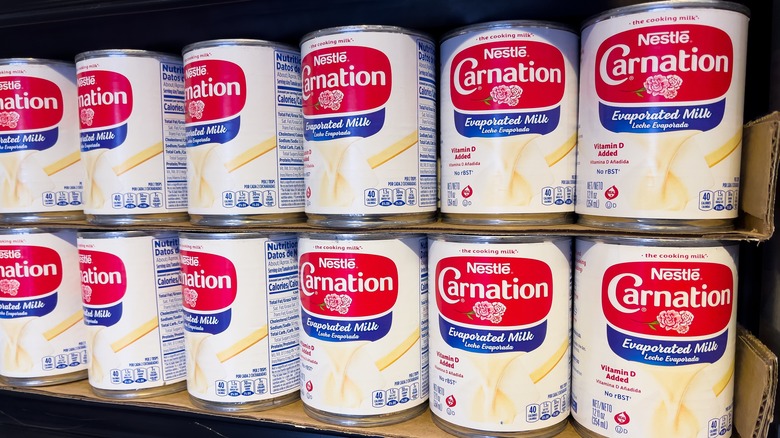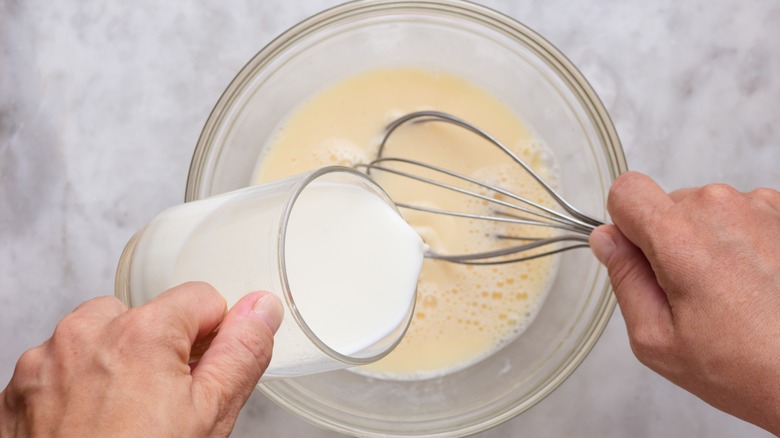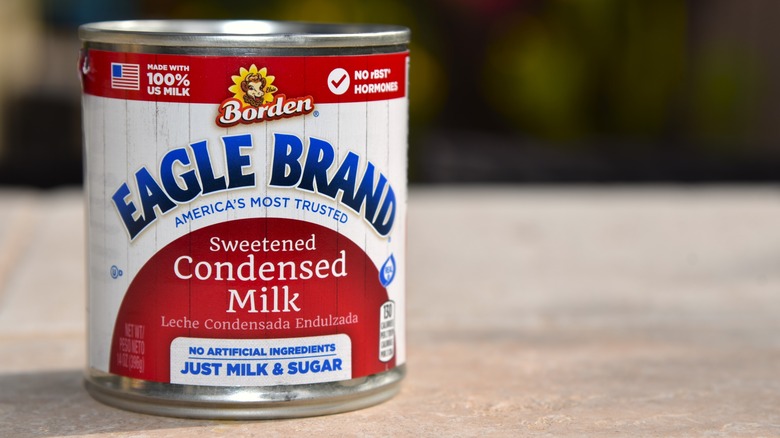2 Easy Ingredient Swaps For Evaporated Milk In A Recipe
Evaporated milk is common in baking recipes (for example, it's integral to a good tres leches cake), but it can also be used in many other ways, including savory recipes from soups to curries. But if you find yourself short on it, never fear: There are a couple of easy ways to substitute it.
Firstly, you can just make it yourself. As the name suggests, evaporated milk is (surprise!) milk that's been evaporated — or to be more detailed, milk that's been boiled down to reduce its water volume and make it thicker. This process is fairly straightforward, since all you need is a saucepan and some milk, although it can get a little finicky when it comes to knowing how much to boil it down by. The general idea is that you want to reduce the water content by 60% — but that calculation gets more difficult when you bear in mind that milk also has fat in it (so, it's not just a matter of reducing the milk by ⅗).
A good measure is to start with 2¼ cups of 2% milk and reduce it to a cup. Skim, 2%, and whole milk can be used to make evaporated milk, but be aware that for this specific recipe a fattier milk might need a little less boiling (since it has a higher fat-to-water ratio) while skim milk might need more.
You can also substitute it without boiling
If you don't have time to wait for milk to reduce down in a pan, it's also possible to substitute evaporated milk with some types of plain, non-evaporated milk. However, you'll want to be a bit more careful here. Evaporated milk is generally thicker and creamier, so using a non-evaporated alternative may alter the consistency of a recipe — be especially careful if you're baking, since it could make for an overly thin batter.
If you want to use non-evaporated milk as a substitute, you should opt for whole milk or something fattier: Evaporated milk is characterized by its relatively high fat content, so if you go for something like 2% or skim milk, you're moving further away from an accurate substitute. Some cooks suggest going even fattier: You could do a one-to-one substitute of half and half. Half and half is a bit fattier (a minimum of 10.5% fat, compared to 6.5% for evaporated milk) and with less protein, but the general consistency is somewhat similar. That said, you'll miss out on the faintly caramelized taste that evaporated milk gets from being cooked down. A one-to-one substitute of heavy cream also works if you're going for the consistency of evaporated milk, but be warned that it's a lot fattier, so you'll get a far richer final product.
What about condensed milk?
There are similarities between condensed milk and evaporated milk: Perhaps most notably, they're both centered around regular milk that's been boiled down into a thicker dairy product. But condensed milk generally isn't a good substitute for its evaporated counterpart for a couple of reasons. The main one is that condensed milk has a lot more sugar (packaging often describes it as "sweetened condensed milk" — while evaporated milk has around 12% sugar, condensed milk can have as much as 50% sugar.
While both these milks have their water content reduced by about the same amount, all the extra sugar in condensed milk also means it's a substantially thicker consistency — it's more of a thick, honey-like texture compared to the relatively liquid evaporated milk. These major differences mean they're not generally considered interchangeable, as both the flavor and texture are too far apart. If you're really stuck, you could try substituting condensed milk for evaporated (this would only work in sweet recipes like baked goods, due to the sugar content), but you'd want to cut sugar from elsewhere in the recipe — and you should definitely assume that there's a good chance of not getting ideal results.


